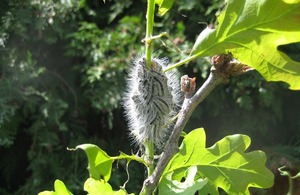Oak processionary moth – warning issued ahead of hatching season
Public and construction trade vigilance needed as greatest risk period for oak processionary moth (OPM) begins.

Image of an oak processionary moth caterpillar
The public are being urged to be vigilant for any sightings of oak processionary moth caterpillars, a tree pest which can strip oak trees of their foliage and leave them susceptible to disease.
The caterpillars - predominantly found in South East England - descend down oak trees in head-to-tail processionary form, occasionally taking the form of an arrow shape, earning them their name. They feed on the leaves as they migrate causing the leaves to sometimes drop off which negatively impacts their growth. This can weaken the tree and leave it more vulnerable to other stresses, such as drought and further diseases.
The warning has been issued today by the Forestry Commission who are urging the public to report any sightings to the via the TreeAlert portal or by email to opm@forestrycommission.gov.uk.
Oak processionary moth was first identified in London in 2006 after being accidentally transported over from Europe in trees for planting. It has since spread to surrounding counties in the South East, and last July, a small outbreak of the caterpillars were found at a site designated free from the pest.
OPM caterpillars and their nests, which are made of distinctive white silken webbing,contain hairs that can cause itchy rashes, eye and throat irritation and should not be touched under any circumstances. The nests can be found in the trunk or branches of Oak trees, and fade to a light brown over time, the public are urged never to try and dispose of the nests themselves.
Andrew Hoppit, Oak Processionary Moth Project Manager, said:
“It is important those living and working in areas affected by oak processionary moth remain vigilant about the health risks they pose, when enjoying outdoor spaces, as we are entering the greatest risk period.
“The Forestry Commission has a whole host of information online that can be used to identify the moth, simply visit managing oak processionary moth in England. If you spot the pest, report the sighting via our TreeAlert portal. Alternatively, you can email opm@forestrycommission.gov.uk.”
Forestry Commission continue to undertake a rapid management response and extensive surveillance work is in place to monitor the area and continue to direct appropriate control measures to prevent their potential spread.
Professor Nicola Spence, UK Chief Plant Health Officer, said:
“Oak trees are an iconic and much-loved part of our British landscape. By reporting any sightings of the oak processionary moth to the Forestry Commission, we can all minimise the pest’s spread as well as reduce their impact on tree health.
“I would advise that members of the public living in London, the surrounding areas and Derbyshire, avoid any contact with the caterpillar and its nests, as this can cause irritation.”
By identifying threats such as pests and diseases, we protect the benefits plants provide to the public, to wildlife, the environment, and our economy. More information can be found on the Plant Health Action.org website.
How to identify Oak Processionary Moth caterpillars
- Nests are typically dome or teardrop-shaped, averaging the size of a tennis ball. They are white when fresh, but soon become discoloured and brown. The caterpillars have black heads and bodies covered in long white hairs which contain proteins which can cause itchy rashes, eye, and throat irritations. They can also occasionally cause breathing difficulties in people and pets, so should not be touched under any circumstances.
- A public information leaflet covering how to identify OPM and methods to control is available,
- There is also a document outlining species commonly confused with OPM which can be found here.
- For more information, visit ‘Managing Oak Processionary Moth in England’.
Notes to Editors
Contact with Oak Processionary Moth
- Following possible OPM contact, visit your pharmacist for relief from milder skin or eye irritations. Consult a GP or call NHS111 for more serious reactions. Contact a vet if animals are seriously affected.
- An interactive map showing the locations of recent confirmed reports of OPM and the national management zones is available.
- A toolkit for local authorities and larger landowners to help plan for and manage OPM has been developed by the Tree Council, in partnership with Forest Research.
- A guide for the policy changes to OPM management
Further information on support for those affected by Oak Processionary Moth:
- Defra and the Forestry Commission offer a grant to support local communities to respond to OPM in the Established Area within London and the South-East.
- It pays for a facilitator (such as a Local Authority) to form a group of land managers with oak trees on their land and create an OPM management plan for the group, as well as the hire of contractors to survey their oak trees for OPM. Funding is also available for signage and biosecurity items including boot cleaning equipment and red tape/posts for cordoning off areas.
- For more information and details of how to apply see https://www.gov.uk/government/publications/tree-health-pilot-scheme-2023/grants-for-oak-with-oak-processionary-moth-opm